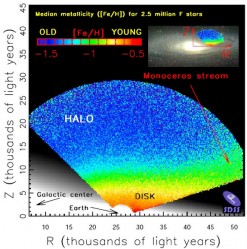An international team of astronomers from the Sloan Digital Sky Survey unveiled a new detailed map of the chemical composition of more than 2.5 million stars in the Milky Way. This new map could help reveal the unknown ancient history of our galaxy. “With the new SDSS map, astronomers can begin to tackle many unsolved mysteries about the birth and growth of the Milky Way,” said Zeljko Ivezic, a University of Washington astronomer, and leader of the study.
Astronomers use the term “metals” to describe all elements heavier than hydrogen and helium, including the oxygen we breathe, the calcium in our bones, and the iron in our blood. Although hydrogen, helium and traces of lithium were created at the beginning of the Universe in the Big Bang, all other elements (such as iron and carbon) were forged in the cores of stars or during the explosive deaths of massive stars.
As a result, stars that formed early in the history of the Galaxy (some 13 billion years ago) were made of gas that had few metals created by the generations of stars that came before. These “metal-poor stars” provide astronomers with a chemical fingerprint of the origin and evolution of the elements. As subsequent generations of stars formed and died, they returned some of their metal-enriched material to the interstellar medium, the birthplace of later generations of stars, including our Sun.

Previous chemical composition maps were based on much smaller samples of stars and didn’t go as far as the distances surveyed by SDSS-II — a region extending from near the Sun to about 30,000 light years away. The construction and first implications of the map are described in a paper titled “The Milky Way Tomography with SDSS: II. Stellar Metallicity,” slated to appear in the August 1 issue of The Astrophysical Journal.
“By mapping how the metal content of stars varies throughout the Milky Way, astronomers can decipher star formation and evolution, just as archaeologists reveal ancient history by studying human artifacts,”explained University of Washington graduate student Branimir Sesar, a member of the research team.
Sources: ArXiv, Sloan Digital Sky Survey


Sub: Milky Way Galaxy interlinks COSMOLOGY.
COSMOLOGY DEFINITION:
Cosmology is a borderland between science and Philosophy
Cosmology deals with Multi-Universe concepts and the Universe as part of Cosmos.
Cosmology details Creation, stability and dissolution of the Universe or parts thereof.
Cosmology covers broad Prime drive functions and links :
COSMOLOGY FROM PHILOSOPHY TO VEDAS
1. Cosmology in Vedas 2.Cosmology in Philosophy 3.Science of Philosophy
4. Basic Philosophy
FROM SCIENCE TO COSMOLOGY
1. Basic Science 2. Philosophy of Science 3.Cosmogony-Astrophysics
4. Cosmology -Present Day under Revision
NATURE TO COSMIC DIVINE
1.Nature 2.Divine Function in Nature 3. Divine Universe 4.Cosmos Divine
Key Words: Cosmology Definition, Cosmology Primer, Cosmology Drive,
Cosmology Science, cosmology Vedas, Cosmology Philosophy, Cosmology Nature,
Cosmic Divine Function, Cosmology interlinks, Cosmology Space Science,
Cosmology Knowledge Base, Knowledge Expansion, creation in the Universe,
Stability of the Universe , Dissolution of the part of the Universe
Ref:COSMIC YOGA VISION SERIES-II: Centre of the Universe
Heart of the Universe-Nov 2006 -Book By Vidyardhi Nanduri
Copy Rights TXU 1-364-245 –
The Science in Philosophy- Pridhvi Viswam Asya Dharineem Cosmos yoga vision series-II- cover upto 10^5 Light Years —Vidyardhi Nanduri,
Reproduced from : HEART OF THE UNIVERSE by Vidyardhi Nanduri, Nov 2006,[Book}
This is excellent basic research, Vidyardhi Nanduri’s comments notwithstanding. I suppose SDSS has a free-standing model of our galaxy, as distinct from a photographed model, and the scientists there can visit and comment on any star in it. I suppose the people at SDSS are a little less Sol-centred. Good, and well done.